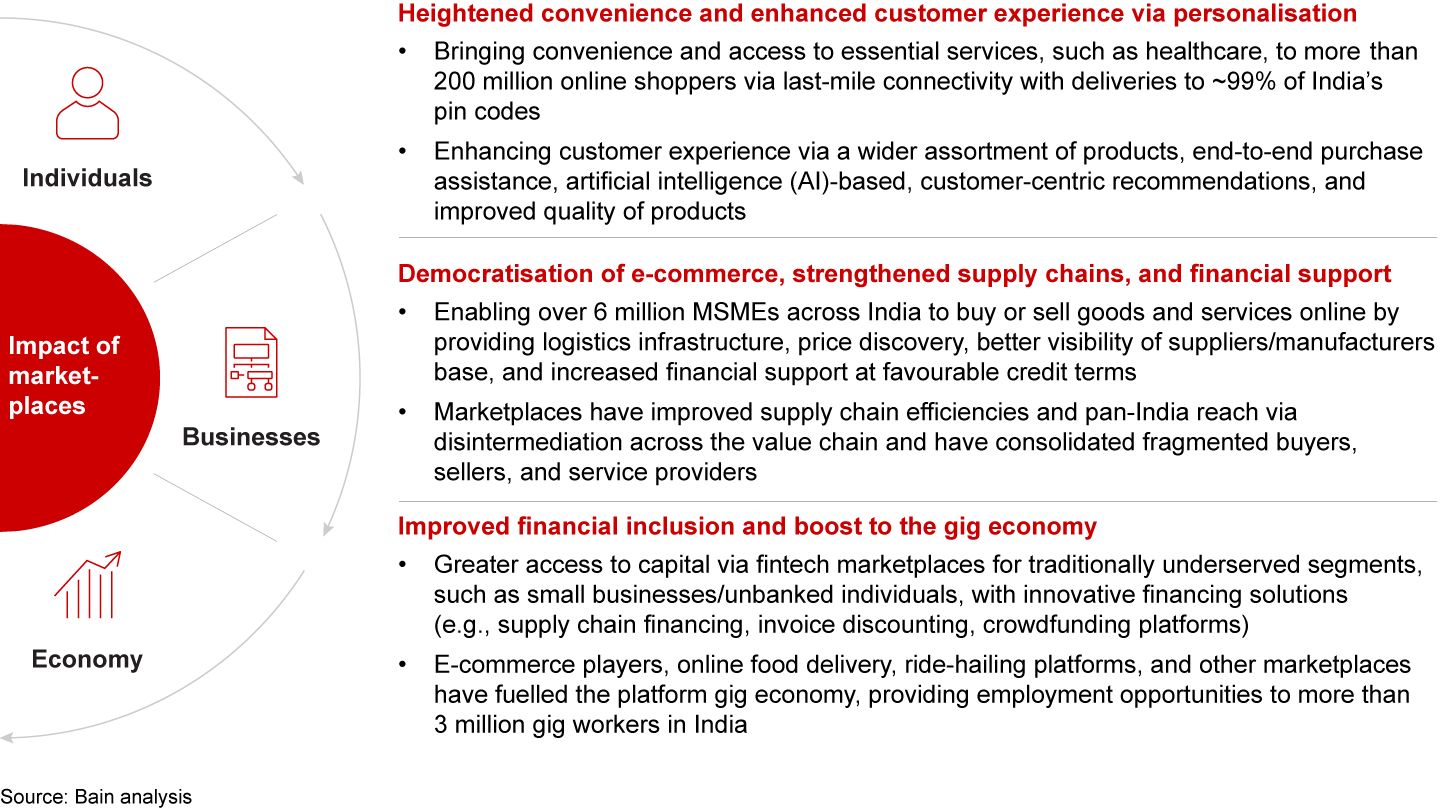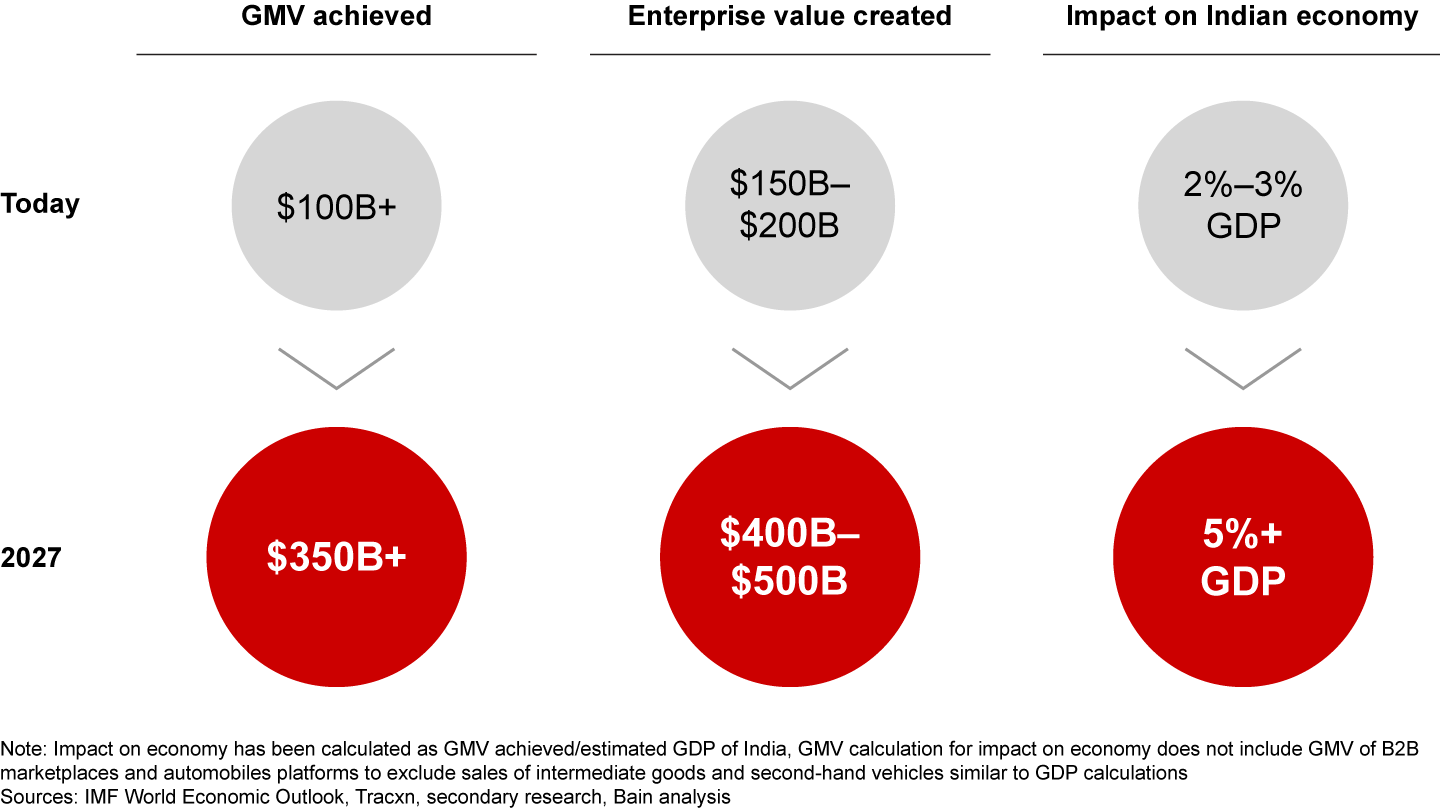Report

India presents itself as one of the most exciting places globally for marketplaces to thrive—with large offline markets and more than $2 trillion of consumption expenditure, rising disposable incomes driven by middle-class expansion, and an increasingly digitised base of online shoppers and small businesses. Today, marketplaces in India are ubiquitous across every major business category, contributing more than $100 billion in gross merchandise value (GMV); delivering heightened convenience and a plethora of choices to 200 million to 230 million online shoppers; and offering logistical and financial support to more than 6 million micro, small, and medium enterprises (MSMEs), enabling them to buy and sell goods or services online. Moreover, marketplaces have reimagined existing value chains by consolidating fragmented demand and supply, eliminating intermediaries, and offering pan-India reach to businesses. The overall economy has also benefitted immensely, as marketplaces have improved financial inclusion by providing traditionally underbanked segments with greater access to capital. Marketplace models like e-commerce, food delivery, and ride-hailing platforms have also provided a major boost to the gig economy by creating more than 3 million jobs.
Written in collaboration with
Written in collaboration with

This has allowed India to cultivate a vibrant and successful marketplace landscape, demonstrated by the sheer breadth of more than 300 funded marketplaces across multiple categories (retail, education, healthcare, travel, financial services, etc.). As of today, around 20 marketplaces have achieved more than $1 billion in GMV, and many players have turned profitable.
As a result, marketplaces have also seen significant traction with investors in recent years. 2021 was a landmark year for marketplaces, as funding reached $16 billion (growing four times compared to 2018 funding), more than 135 companies raised funding, and more than 45 companies drew Series C+ capital. Recently, investor confidence in this model has been further bolstered by marquee exits via a slew of marketplace initial public offerings (IPOs) such as Nykaa, Zomato, and Policybazaar, among others.
While the marketplace model is popular across multiple categories, upstream business-to-business (B2B), fintech, and shipping and logistics are some of the most exciting areas. These sectors show evidence of successful marketplaces as well as significant headroom for growth for new or emerging players:
- Upstream B2B marketplaces such as Fashinza are marketplaces connecting brands/ manufacturers/service providers with vendors/suppliers for inputs. These were driven by a spike in digitisation of MSMEs, consolidation of fragmented buyer/supplier base, and significant improvement in supply chain efficiencies. Future growth is expected to be bolstered by government schemes like Production Linked Incentive (PLI) and a large cross-border opportunity.
- Fintech marketplaces such as Yubi gained traction as they accelerated financial inclusion and literacy for underbanked MSMEs and new-to-credit customers, provided greater access to capital and diverse investment products to retail investors, and enabled better capital utilisation for lenders.
- Shipping and logistics marketplaces such as BlackBuck saw a surge of tech-based players strengthening the logistics ecosystem by building innovative business models that solve for long-haul and short-haul inefficiencies and address demand and supply side pain points.
Going forward, in addition to the next-generation marketplaces in above-mentioned areas, we expect the next wave of scale marketplaces to emerge in two major categories:
- Bharat-first: Increasing Tier-3+ (T3+) participation has resulted in the gradual adoption of innovative e-commerce models (e.g., focus on voice/vernacular technologies to drive adoption in T3+ consumers and farm-focused agritech marketplaces to empower farmers in Bharat).
- Global cross-border opportunity: A large addressable market (approximately $1 trillion exports by 2027) and favourable government initiatives present a tremendous opportunity for cross-border marketplace players.
Further, evidence of success in mature markets such as the US and China indicate that categories such as gaming, caregiver services, real estate reservations, creative content, and Web 3.0 are potential white spaces in India for marketplaces to emerge in.
With tailwinds from strong macro factors and continued investor support, Indian marketplaces are a mega opportunity that will have a lasting impact on the India growth story in the next five years. Marketplaces are slated to collectively achieve more than $350 billion in GMV, create $400 billion to $500 billion in enterprise value, reach 400 million to 450 million online shoppers, enable more than 15 million MSMEs to grow their businesses online, and create 7 million jobs by 2027.









